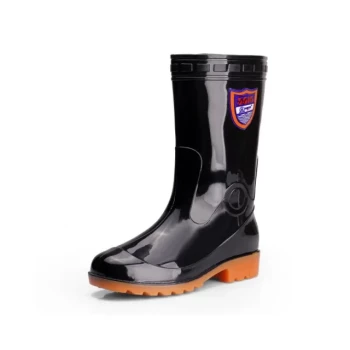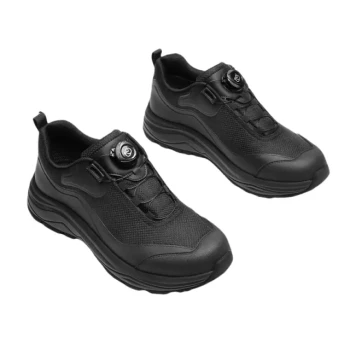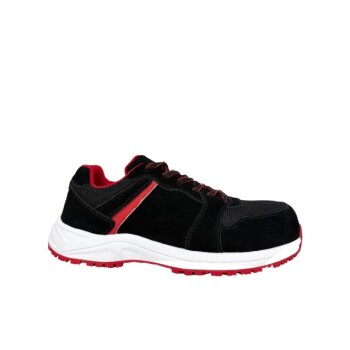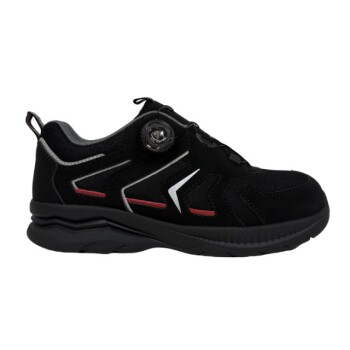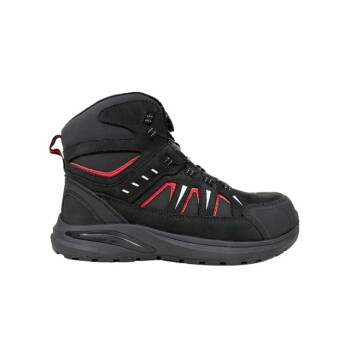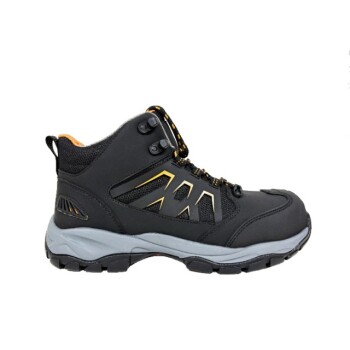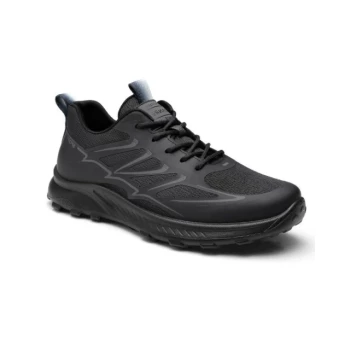At its core, the difference is one of purpose. A hiking shoe is engineered for support and durability under load, prioritizing stability on rugged terrain. A trail running shoe is engineered for lightweight flexibility and agility, prioritizing speed and a responsive feel for moving quickly over the ground.
The decision between them is a fundamental trade-off between protection and weight. Hiking shoes offer more robust protection and support for your feet, while trail running shoes reduce fatigue by minimizing weight, allowing for greater speed and agility.
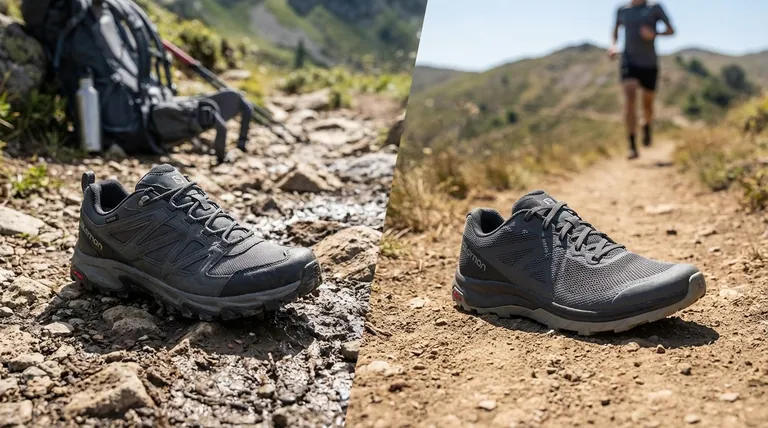
The Core Design Philosophy: Stability vs. Agility
Understanding the intended use of each shoe is the key to telling them apart. They are not interchangeable tools; each is optimized for a different kind of movement in an outdoor environment.
Hiking Shoes: Built for Support and Durability
Hiking shoes are essentially low-cut versions of traditional hiking boots. Their primary function is to provide a stable platform for your foot on uneven, unpredictable surfaces.
They are designed to handle the stress of carrying a backpack and protect your feet from rocks and roots over many miles. This is why they feel stiffer and more substantial.
Trail Running Shoes: Engineered for Speed and Flexibility
Trail running shoes are purpose-built for running on natural surfaces. They are essentially toughened-up road running shoes, modified for the demands of the trail.
Their design prioritizes impact absorption, a flexible sole that allows the foot to adapt to the terrain, and lightweight materials that won't slow a runner down.
Key Differences in Construction
The philosophical difference between stability and agility manifests in every component of the shoe, from the sole to the upper materials.
Midsoles: Rigidity vs. Cushion
The midsole is the engine of the shoe. A hiking shoe has a denser, more rigid midsole that acts as a shield, preventing sharp objects from poking through from below. This creates a very stable footing.
A trail running shoe has a softer, more cushioned, and highly flexible midsole designed to absorb the repetitive impact of running and allow for a natural stride.
Outsoles: Durability vs. Grip
Both shoe types feature aggressive, "lugged" outsoles for traction. However, hiking shoe outsoles often use harder rubber compounds designed for maximum durability on abrasive surfaces like granite.
Trail running shoes may use stickier, softer rubber compounds that provide exceptional grip but wear out more quickly.
Uppers: Protection vs. Breathability
The upper part of a hiking shoe is typically made from more robust materials, including leather or tough synthetic fabrics, to resist abrasion and protect your foot.
In contrast, trail running shoes almost always feature lightweight, breathable mesh uppers. This helps with temperature regulation and allows the shoe to drain and dry quickly after getting wet.
Understanding the Trade-offs
Neither shoe is universally "better." The correct choice depends entirely on your activity and priorities.
The Support Factor
For backpackers carrying weight, the support of a hiking shoe is critical. The stiff sole and supportive structure help prevent foot fatigue and reduce the risk of twists or sprains under load.
A trail runner offers minimal support, which is acceptable for an unburdened hiker or runner but can become problematic when a heavy pack is added.
Durability and Longevity
A hiking shoe is built to last. Its tougher materials and more rugged construction mean it will withstand far more abuse than a trail runner.
Trail running shoes are a consumable for serious runners. Their lightweight mesh and softer soles will break down and wear out significantly faster, especially if used for rugged, off-trail hiking.
When Hiking Shoes Can Be Too Much
For simple walks on well-maintained paths or in warm climates, a heavy-duty hiking shoe can feel clunky and hot.
In these situations, the lighter weight and superior breathability of a trail runner can provide a more comfortable experience, even if you are just walking.
Making the Right Choice for Your Activity
Your decision should be based on three factors: the terrain, the weight on your back, and the speed you intend to move.
- If you are a day hiker on varied or rocky trails: A hiking shoe is the classic choice, providing an ideal balance of support, protection, and comfort.
- If you are a backpacker carrying a moderate to heavy pack: A hiking shoe (or its mid/high-cut boot equivalent) is the definitive choice for its superior stability.
- If you are an ultralight backpacker or a "fast-packer": A trail running shoe is often preferred to maximize speed and minimize weight.
- If you are walking on simple nature paths in fair weather: A trail running shoe offers excellent comfort and breathability for less demanding walks.
Ultimately, choosing the right footwear is about matching the tool to your specific goal on the trail.
Summary Table:
| Feature | Hiking Shoes | Trail Running Shoes |
|---|---|---|
| Primary Use | Hiking with a pack, rugged terrain | Running or fast hiking, natural surfaces |
| Key Trait | Stability, Support, Durability | Lightweight, Flexibility, Agility |
| Midsole | Rigid for protection | Soft & cushioned for impact absorption |
| Upper | Robust leather/synthetics for protection | Lightweight mesh for breathability |
| Best For | Backpacking, carrying weight, rocky trails | Speed, agility, well-maintained paths |
Ready to Equip Your Customers with the Perfect Footwear?
As a large-scale manufacturer, 3515 produces a comprehensive range of durable hiking shoes and lightweight trail running shoes for distributors, brand owners, and bulk clients. Our production capabilities ensure you get the right footwear for your market, combining quality construction with the performance your customers demand.
Let's discuss your specific needs and how we can support your business.
Contact our team today to request a quote
Visual Guide

Related Products
- Durable Rubber Sole Outdoor Shoes Wholesale & Custom Manufacturing
- Safety Footwear Wholesale Manufacturer for Custom OEM/ODM Production
- Durable Waterproof Rain Boots | Custom Manufacturer for Wholesale & Brands
- Durable Rubber-Soled Utility Shoes for Wholesale & Custom Brand Manufacturing
- Wholesale Training Shoes with Dial Lacing System Custom OEM Manufacturing
People Also Ask
- Why are rubber-soled shoes considered multi-weather footwear? Unlock All-Season Traction & Protection
- What were traditional shoe soles made from before rubber? The History of Leather Soles
- What are the main applications of vulcanized rubber? Unlock Durability for Tires, Footwear & More
- How does cushioning work in hiking shoes? The Science of Shock Absorption
- What are the disadvantages of vulcanized soles? Lack of Support & Durability Explained


